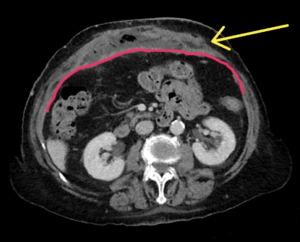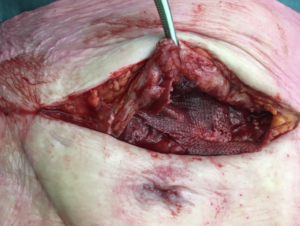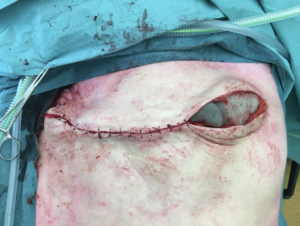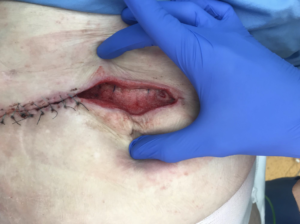Case Study
Management of Chronic Mesh Infection with Negative Pressure Wound Therapy with Instillation and Dwell Time (NPWTi-d): a Case Report
VP Alberts1, MA Boermeester1
1Department of Surgery, Amsterdam University Medical Center, The Netherlands
Authors report no conflicts of interest
Word count: 1045
Academic Medical Center, Meibergdreef 9, 1100AZ, Amsterdam, The Netherlands. Corresponding author: Victor P Alberts, [email protected]
ABSTRACT
Introduction. Infection of surgical meshes is a major complication after abdominal wall reconstruction and often leads to the complete removal of the mesh, resulting in additional major surgery and recurrent hernia. Recently, V.A.C. VERAFLO™ NPWTi-d was applied on patients with infected meshes in our Medical center.
Methods. In this case report, V.A.C. VERAFLO™ was applied post-debridement (for reduction of bioburden, without complete mesh removal) to a patient with mesh infection, using cycles of 2.5 hours of negative pressure at 75 mmHg, followed by 15 minutes soaking with 110 ml normal saline for two weeks with 4 dressing changes. Subsequently, the wound was closed and PREVENA™ wound management system applied.
Results. After V.A.C. VERAFLO™ and PREVENA™ treatment, the patient developed a small abscess for which percutaneous drainage was applied, but remained free of infection.
Conclusions. This case report describes a successful treatment of mesh infection with NPWTi-d without the need for more extensive surgery for complete mesh removal. So far, three similar patients were successfully treated this way in our center, as we progress to increase our experience with NPWTi-d for this indication.
INTRODUCTION
One of the most feared complications of abdominal wall reconstruction is the infection of a synthetical mesh. Since an infection of a synthetic mesh does not respond well on antibiotic treatment, these infections are likely to become chronic, and in many cases leads to the need of mesh removal. Often, major surgery is needed for complete removal of the infected mesh with associated morbidity and hernia recurrence.
Negative pressure wound therapy with instillation and a dwell time (NPWTi-d) has recently been introduced to treat infected surgical wounds.1-3 This method combines negative pressure wound therapy with repetitive fluid instillation in the infected wound, and results in a lower local septic load and enhanced recovery of surgical site infections. However, treatment of an infected mesh with NPWTi-d after abdominal wall reconstruction has not yet been reported. In Amsterdam UMC, we have now successfully treated three patients with a chronic infected mesh using V.A.C. VERAFLO™, and so preventing them from major surgery. Hereby, we present a case report.
METHODS
By the time of V.A.C. VERAFLO™ treatment, the presented patient is an 80-year old female with a history of multiple recurring incisional hernias after open cholecystectomy. In 2018, after recurrent admissions for obstructive ileus related to yet another recurrence, she underwent correction of the eighth episode of an incisional hernia, using a biosynthetic reinforcement mesh in the transverse abdominal release (TAR) plane. The rectus abdominis fascia is closed over the mesh.
Post-operatively, she develops a deep surgical site infection, for which she was percutaneously drained and received antibiotic treatment. Subsequently, she developed a chronic infection of the biosynthetic mesh with recurrent subfascial abscesses (figure 1, eight months after initial surgery). After unsuccessful antibiotic and drainage treatment of the infected mesh, the next step would normally be total removal of the mesh with high risk of a recurrent incisional hernia and the need for additional major surgery. However, in this case the infected mesh was treated with V.A.C. VERAFLO™.
Almost one year after placement of the now infected mesh, the wound was opened and the non-integrated, loose parts of the mesh were removed (reduction of bioburden, figure 2). The integrated parts of the mesh comprised the major part of the mesh and were left in place. At this operation, the anterior rectus fascia was left open, Cleanse Choice™ foam was applied, skin was partially closed, and the V.A.C. VERAFLO™ system applied (figure 3). Cycles of 2.5 hours of negative pressure at 75 mmHg were used, followed by 15 minutes soaking with 110 ml normal saline for two weeks with 4 dressing changes. At the first dressing change, the anterior fascia was closed over the remnant mesh, and after two weeks of V.A.C. VERAFLO™ treatment the wound seemed suitable for skin closure (figure 4). After closure of the skin a PREVENA™ closed incision management system was applied.
RESULTS
After V.A.C. VERAFLO™ and subsequent PREVENA™ treatment, the patient developed a small subcutaneous abscess, which was percutaneously drained but has remained free of infection. The successful use of NPWTi-d has prevented the patient from undergoing major surgery.
CONCLUSIONS
The reported patient had a chronic mesh infection for which she normally had to undergo resection of the entire mesh. In this case, only the non-integrated part of the mesh was removed for bioburden reduction and V.A.C. VERAFLO™ NPWTi-d was applied. This resulted in a full clinical recovery of the infection. The integrated parts of the mesh were left in place but were not affected.
In our center, a second 64-year old patient was treated similarly after infection of an intra-abdominal composite mesh with absorbable coating. Initially, she was planned for complete resection of the intra-abdominal mesh after reduction of the bioburden through small-incision resection of the infected parts of the mesh and treatment with V.A.C. VERAFLO™. However, the infection subsided completely after treatment with NPWTi-d and there was no need for additional major surgery to remove the remnant mesh.
NPWTi-d combines negative pressure wound therapy with instillation of the applied wound. In addition to promoting vascularization and granulation tissue formation while reducing oedema, the cycles of installed saline followed by negative pressure cleans the wound from contaminants.4 In our presented case, this resulted in cleansing of a chronic infection by a biosynthetical mesh. The use of NPWTi-d could also be indicated for infected wounds without the presence of a surgical mesh. The device is user friendly and easy to handle. In conclusion, V.A.C. VERAFLO™ seems a save and effective alternative for the treatment of chronic mesh infection.

Figure 1. Long-term infected biosynthetical mesh in TAR position with large fluid collection anterior of the mesh, clear signs of infection. Red = mesh.

Figure 2. The infected biosynthetical mesh in Rives-Stoppa/TAR sublay position is sandwiched in complete closure of the posterior and anterior fascia at the index operation of abdominal wall reconstruction. Here the anterior fascia is opened and the infected non-integrated part of the mesh is visible.

Figure 3. V.A.C. VERAFLO™ applied after debridement (partial mesh removal only of non-integrated mesh in open wound), thereafter complete anterior fascial closure over remnant mesh, and partial skin closure over VERAFLO™ Cleanse foam. At the next dressing change, the in-and-out technique for VERAFLO™ was applied by partial opening of both ends of the wound.

Figure 4. After 2 weeks of V.A.C. VERAFLO™ treatment, the wound is granulated, clean, and suitable for full closure.
REFERENCES
1. Anghel, EL.; Kim, PJ; Attinger, CE. A solution for complex wounds: the evidence for negative pressure wound therapy with instillation. Int Wound J. 2016 Sep;13 Suppl 3:19-24.
2. S.G. Goss,Negative Pressure Wound Therapy With Instillation (NPWTi) Better Reduces Post-debridement Bioburden in Chronically Infected Lower Extremity Wounds Than NPWT Alone MD, J.A. Schwartz, MD, F. Facchin, MD, J Am Coll Clin Wound Spec. 2012 Dec; 4(4): 74–80.
3. Kim PJ, Attinger CE, Steinberg JS, Evans KK, Hung RW, Smith JR, Rocha ZM, Lavery L. The impact of negative-pressure wound therapy with instillation compared with standard negative-pressure wound therapy: a retrospective, historical, cohort, controlled study. Plast Recontr. Surgery 2014; 133: 709- 16.
4. Gupta, S., Gabriel, A., Lantis, J. & Téot, L. (2016). Clinical recommendations and practical guide for negative pressure wound therapy with instillation, International Wound Journal, 13, 159-174.